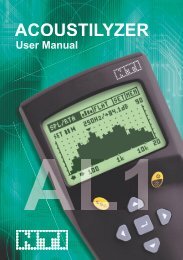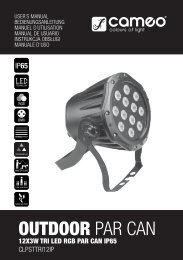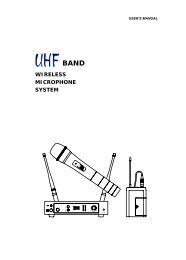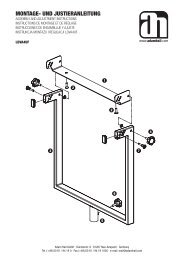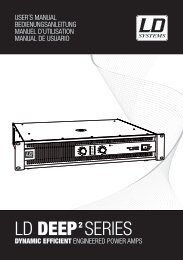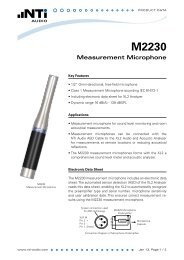Speech Intelligibility - Elma Instruments
Speech Intelligibility - Elma Instruments
Speech Intelligibility - Elma Instruments
You also want an ePaper? Increase the reach of your titles
YUMPU automatically turns print PDFs into web optimized ePapers that Google loves.
Technical Methods<br />
APPlicAtion note<br />
Already back in 1940, Bell Laboratories started to develop measurement<br />
technologies to determine the speech intelligibility.<br />
Nowadays, highly developed algorithms as SII (<strong>Speech</strong> <strong>Intelligibility</strong><br />
Index) and various forms of the STI (<strong>Speech</strong> Transmission<br />
Index) allow measuring speech intelligibility. These techniques<br />
take care of many parameters which are important for intelligibility<br />
such as:<br />
• <strong>Speech</strong> level<br />
• Background noise level<br />
• Reflections<br />
• Reverberation<br />
• Psychoacoustic effects (masking effects)<br />
The basic idea of STI measurement consists in emitting a synthesized<br />
test signals instead of a human speakers voice. The speech<br />
intelligibility measurement acquires and evaluates this signal<br />
as perceived by the listeners ear. Extensive investigations have<br />
shown the relationship between the alteration of speech characteristics<br />
and the resulting speech intelligibility. These findings<br />
are incorporated into the speech intelligibility meter that is able<br />
to display the intelligibility result as a single number between 0<br />
(unintelligible) and 1 (excellent intelligibility).<br />
Figure 2: <strong>Speech</strong> <strong>Intelligibility</strong> may be expressed by a single number value. Two scales<br />
are most commonly used: STI and CIS (Common <strong>Intelligibility</strong> Scale)<br />
www.nti-audio.com Page 3 / 14



